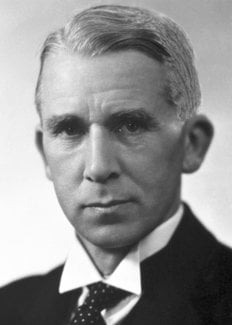Norman Haworth
Biographical

Walter Norman Haworth was born at Chorley, Lancashire, on March 19, 1883. He attended the local school until the age of fourteen when he joined his father, Thomas Haworth, to learn linoleum design and manufacture. His interest in chemistry was aroused through the use of dyestuffs in his work and his thirst for further knowledge led him to seek private tuition in Preston. This coaching enabled him to pass the entrance examination of the University of Manchester and in 1903 he entered the Chemistry Department as a pupil of W.H. Perkin, Junior. He graduated with first class honours in 1906 and after three years research he went, on a scholarship, to Wallach‘s laboratory at Göttingen. He received his doctor’s degree in 1910 and returned to Manchester to be awarded his D.Sc. degree in 1911 – these qualifications were gained in the minimum time possible.
In 1911, Haworth took an appointment as a demonstrator at the Imperial College, London and in 1912 he moved to St. Andrews, Scotland, as Lecturer and Reader in Chemistry. In 1920, he was called to the Chair in Chemistry at the University of Durham and in the following year succeeded Phillips Bedson as Director. Haworth was appointed Professor and Director of the Department of Chemistry in the University of Birmingham in 1925 and he remained in this position until his retirement in 1948, becoming Dean of the Faculty of Science and acting as Vice-Principal during 1947-1948. Sir Norman was active in retirement, serving on many Boards and Committees; he represented the Royal Society at the Seventh Pacific Science Congress in New Zealand during February, 1949. He was knighted in 1947.
Haworth’s early researches, initially with Perkin, involved investigations on the constitution of terpenes and in 1912 he synthesized sylvestrene. At St. Andrews, in association with T. Purdie and J.C. Irvine, he turned his attention to carbohydrates, extending Emil Fischer‘s method of reacting sugars with methanol to an elegant preparation of methylated derivatives which were, in turn, used to characterize the constitution of sugars.
During the First World War, Haworth organized the laboratories at St. Andrews for the production of fine chemicals and drugs; after the war he returned once more to his carbohydrate investigations. By 1928, he had evolved and confirmed, among others, the structures of maltose, cellobiose, lactose, gentiobiose, melibiose, gentianose, raffinose and the glucoside ring structure of normal sugars. He studied lactones from sugars and co-related structure with optical rotatory powers. His method for the determination of chain length in methylated polysaccharides, an important structural problem, helped to settle the basic features of the starch, cellulose, glycogen, inulin and xylan molecules.
Following the synthesis of ascorbic acid, which considerably cheapened commercial production, Haworth’s later researches contributed greatly towards further co-ordination of the chemical, physical and biological, problems concerned with bacterial polysaccharides.
Haworth wrote numerous scientific papers and contributed to Advances in Carbobydrate Chemistry. His book The Constitution of Sugars was published in 1929.
Haworth was President of the Chemical Society (1944-1946), and Fellow (1928), and Vice-President (1947-1948) of the Royal Society. He received honorary science degrees from the Universities of Belfast, Zurich and Oslo, honorary Doctor of Law, University of Manchester, and foreign memberships of nine foreign scientific academies. He was the Longstaff Medallist (Chemical Society), 1933; Davy Medallist (Royal Society), 1934, and Royal Medallist, 1942.
In 1922, Haworth married Violet Chilton, second daughter of Sir James Dobbie, LL.D., F.R.S. They had two sons. He died suddenly on March 19, 1950.
This autobiography/biography was written at the time of the award and first published in the book series Les Prix Nobel. It was later edited and republished in Nobel Lectures. To cite this document, always state the source as shown above.
The Nobel Foundation's copyright has expired.Nobel Prizes and laureates
Six prizes were awarded for achievements that have conferred the greatest benefit to humankind. The 12 laureates' work and discoveries range from proteins' structures and machine learning to fighting for a world free of nuclear weapons.
See them all presented here.
